
Contents










Story · Written by Lee Yongkook Photographed by Studio Kenn
Nature Enshrined
in Literature
Gyeongsangnam-do Province has a wonderful natural environment, with coastal areas and the Hallyeohaesang islands
on the southern end and Jirisan Mountain and the Nakdonggang River on the northern side.
Many literary giants from both the province and the nation have stayed in Gyeongsangnam-do.
The landscape where they built their lives and felt at peace is mentioned in works marking a new era in Korea’s
modern literature. A journey to literary spots nestled in every corner of the province offer unique stories.
Hadong-gun County, with a population of under 50,000, frequently appears as the setting in Korean literature because of the solemnity of Jirisan Mountain combined with the peacefulness of the Seomjingang River creating a unique charm that has attracted writers. Pak Kyong-ni, considered a virtuoso of Korean literature, discovered the Pyeongsari field in the township of Akyang-myeon and made it the setting for her epic novel Toji (Land). Written over 26 years, the book deals with people from all walks of life and chronicles relationships through the eyes of five generations of a Korean family. To properly view the field, one must climb to the nearby Gososeong Fortress, designated Historic Site No. 151. A skywalk recently built for visitors allows easier access to the field. Once at the fortress, visitors can gaze at the field, where the Jirisan ridge wraps up like a folding screen from Hyeongjebong Peak on the left to Gujaebong Peak on the opposite side. The Seomjingang River flows gallantly to the right. I descended from the fortress and headed toward the shooting location of the TV series of Toji. The reenacted settings in the novel were built at the time of filming at the home of vice ministers Choi, Yongine and Dumanne. The Literary Hall and the Hanok Experience House were also worth checking out.
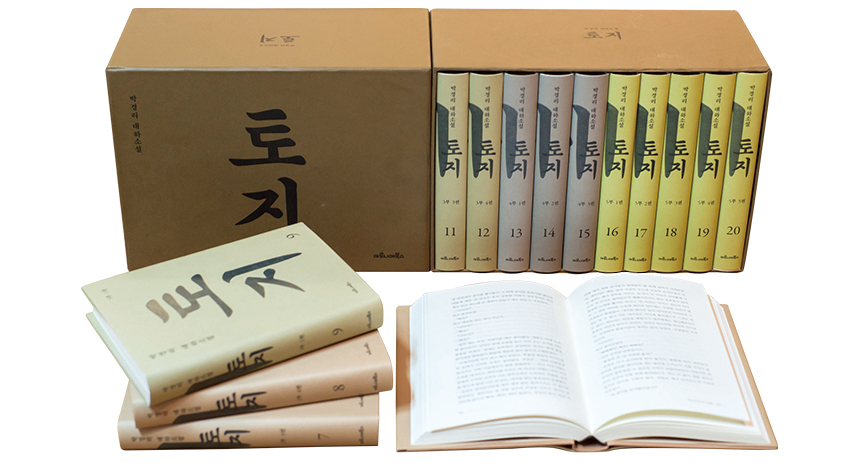
Pak Kyong-ni’s Land is recognized as the pinnacle of literature in Gyeongnam. © Maroniebooks
Walking along the riverside on the so-called Land Trail allows one to reach Hwagae Market, which serves as the background of Kim Dong-ni’s novel Post Horse. The market is situated on the border of the Gyeongsang-do and Jeolla-do provinces, with the river in between, and this geographical characteristic allows Hwagae to symbolize harmony between the Yeongnam and Honam regions. The market was once nationally renowned, trading wild edible greens and medicinal herbs produced in the vicinity of Jirisan and rice and barley from Jeolla-do’s grain belt. It also features household items sold by peddlers and a variety of fishery goods like seaweed and mackerel carried by fishermen in the vicinity of the southern coast via the river. Simni Cherry Blossom Road, another setting in Post Horse referring to the road leading from the market to the Buddhist temple of Ssanggyesa, is famous for cherry blossoms. Such flowers make the road one of Korea’s most beautiful paths. Whether it be spring or another season, the promise of a long and leisurely walk under trees over 50 years or more is a good reason to drop by.
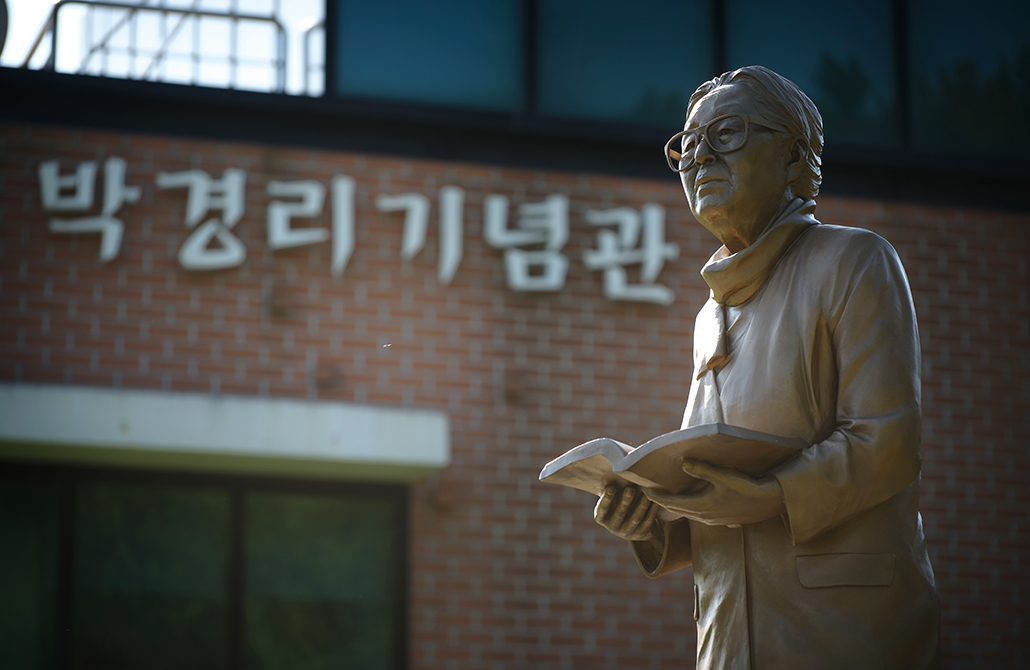 A statue of Pak Kyong-ni with an opened book can be seen standing in front of Pak Kyong-ni Memorial Hall.
A statue of Pak Kyong-ni with an opened book can be seen standing in front of Pak Kyong-ni Memorial Hall.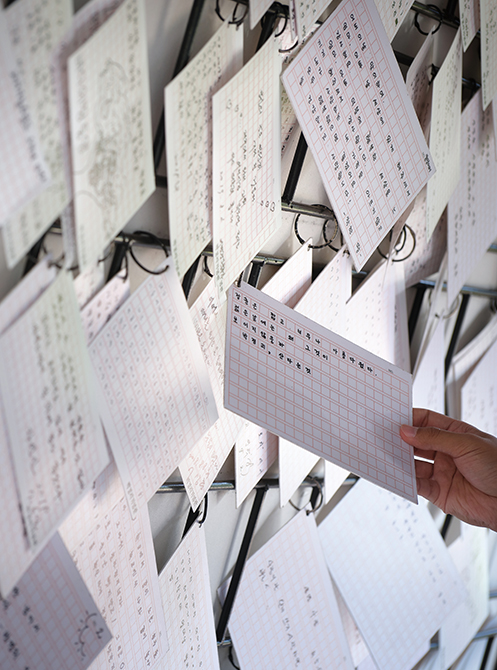 The wall is filled with manuscript papers transcribing Pak Kyong-ni’s works.
The wall is filled with manuscript papers transcribing Pak Kyong-ni’s works.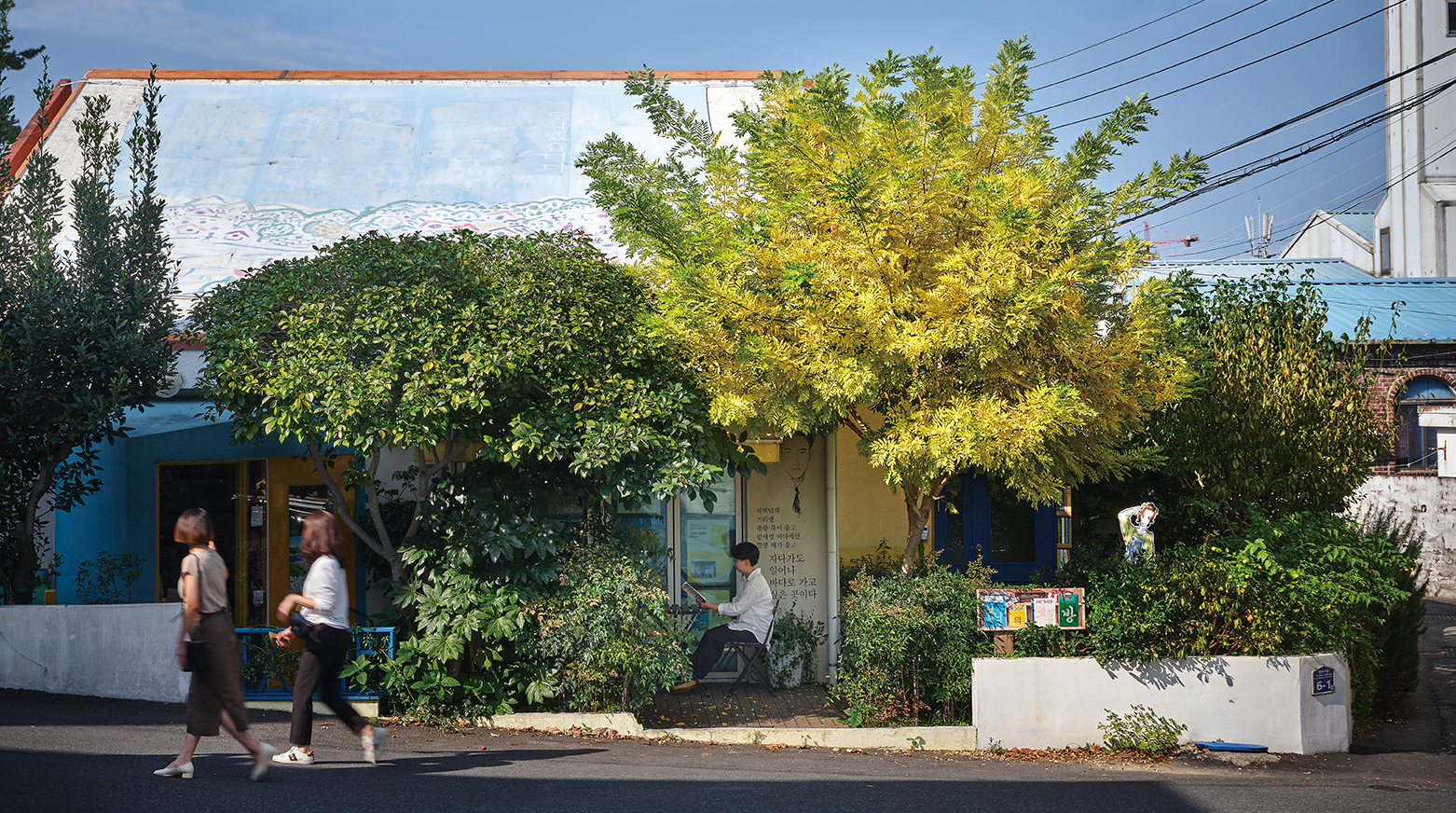
City of Lyricism and Romance
Tongyeong is a small fishing port near the Dadohae archipelago. It is situated at the halfway point of the Busan-Yeosu sea route, and young people there call it the “Naples of Joseon.” The color of the sea there is clear and blue.
-Excerpt from Pak Kyong-ni’s novel The Daughters of Pharmacist Kim
As mentioned in the above novel’s opening, Tongyeong is called the “Naples of Korea” given the Korean port’s quiet beauty and numerous nearby islands. Novelist Pak vividly described places in the city in her novel The Daughters of Pharmacist Kim such as Seomun Pass, Daebatgol Cave, Ganchanggol, Myeongjeongsaem, Chungryeolsa Temple, camellias hundreds of years old and large zelkova trees.
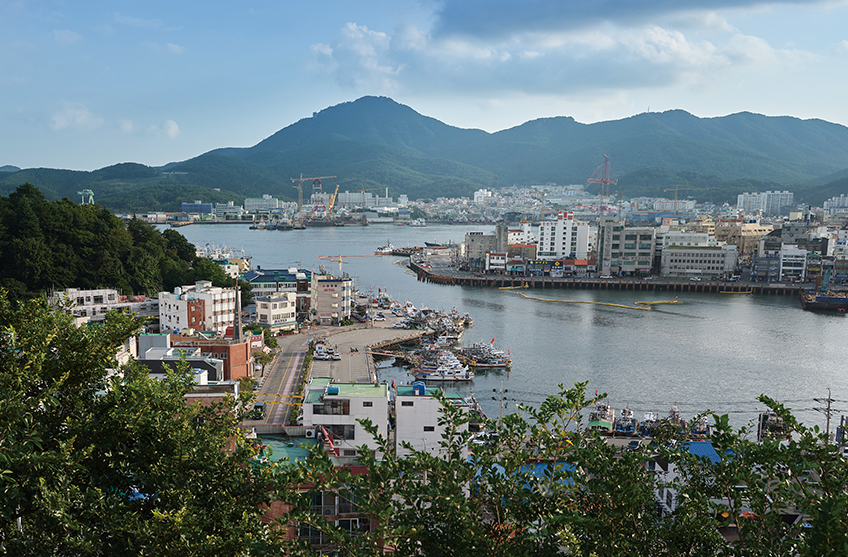
You can overlook the sea near Tongyeong, which is featured in many literary works and the lives of various authors, from Dongpirang and Seopirang.
Among the numerous literary figures who came to Tongyeong for inspiration, poet Yu Chi-hwan, whose pen name was Cheongma, left an indelible mark on the city. Cheongma Street is on a 200-meter road from his birthplace to Tongyeong Central Post Office, and the street’s name has a bittersweet story behind it. Yu, a teacher at Tongyeong Girls’ Middle School, fell in love with Lee Yeong-do, a fellow teacher and sijo (traditional poetry) poet. Yet Yu was married with children, but he sent more than 5,000 love letters to Lee over 20 years through the post office. A memorial stone at the post office is inscribed with the poem “Happiness,” which Yu sent to Lee.
Cheongma Yu Chi-hwan Memorial Hall hosts the Cheongma Literature Festival and the Cheongma Flower Festival every autumn to honor the poet. Covering 12 hectares, the venue of these events also feature magnificent views created by the cosmos, sunflowers and other flowers in bloom during fall.
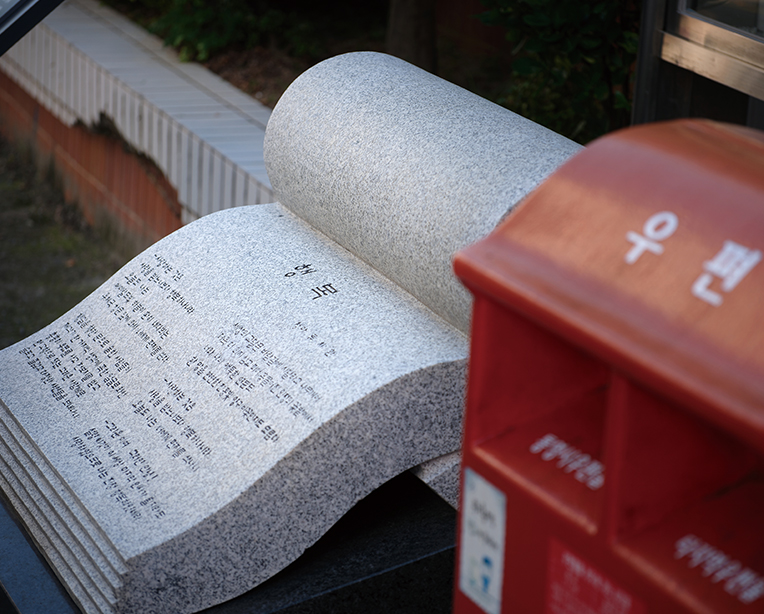 A sculpture written with Happiness, a poem by Yu Chi-hwan (pen name: Cheongma), can be seen situated next to a post box in Jungang-dong Post Office.
A sculpture written with Happiness, a poem by Yu Chi-hwan (pen name: Cheongma), can be seen situated next to a post box in Jungang-dong Post Office.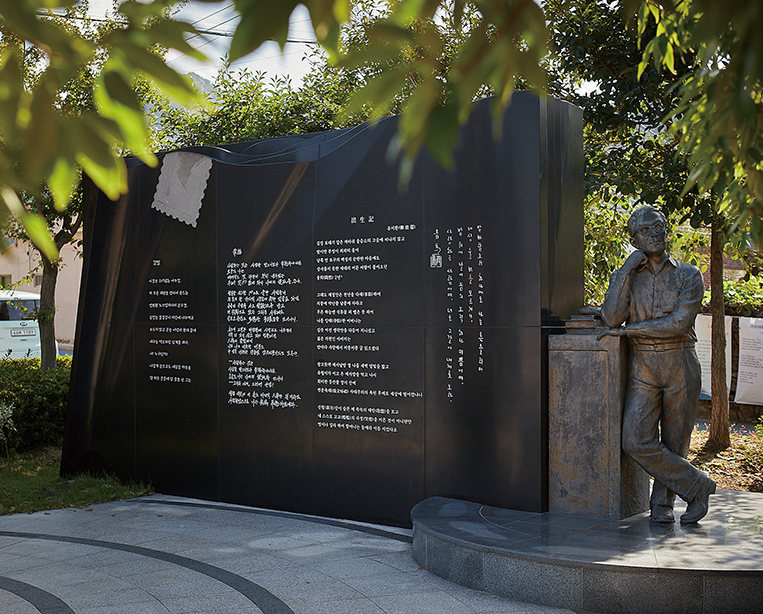 Classic lines from Cheongma Yu Chi-hwan’s poems can be seen inscribed next to his statue.
Classic lines from Cheongma Yu Chi-hwan’s poems can be seen inscribed next to his statue.Healing Literature
My final destination after leaving Geojedo Island was Changwon, where a number of famous writers stayed for an unusual reason. Back then, Masanhappo-gu District was famous for recuperation from and treatment of tuberculosis, and literary figures with TB sought out this city to both treat their condition and conduct their activities. Thus the disease, healing and literature combined to form the so-called network Tuberculosis Literature.
Aside from writers who left after a short stay, Lee Won-su, a leading figure in children’s literature, and Kim Daljin, a lyrical poet and Buddhist monk who worked as a teacher during his lifetime, were from Changwon. The city’s Sosa Village houses Kim Daljin Museum, whose exhibits feature the writer’s life. The Kim Daljin Literary Festival is held here every fall and hosts lively events including poetry readings and literary lectures. Art Street near the hall reenacts scenes from daily life before the 1970s, appealing to those interested in the nation’s past.
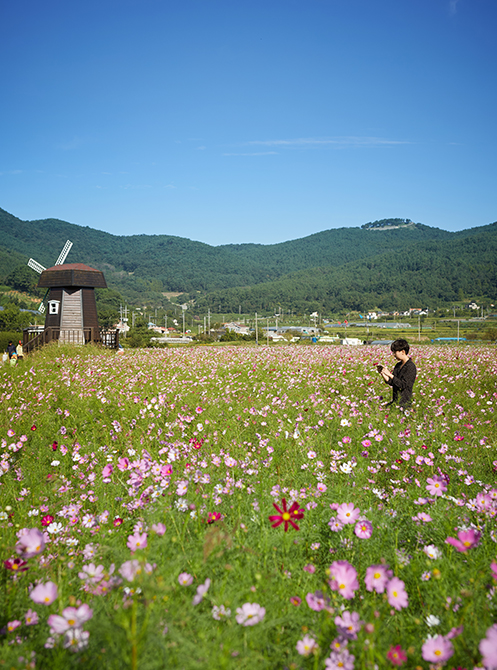 A festival honoring Cheongma Yu Chi-hwan is held annually in the cosmos field, stretching in front of Cheongma Yu Chi-hwan Memorial Hall.
A festival honoring Cheongma Yu Chi-hwan is held annually in the cosmos field, stretching in front of Cheongma Yu Chi-hwan Memorial Hall.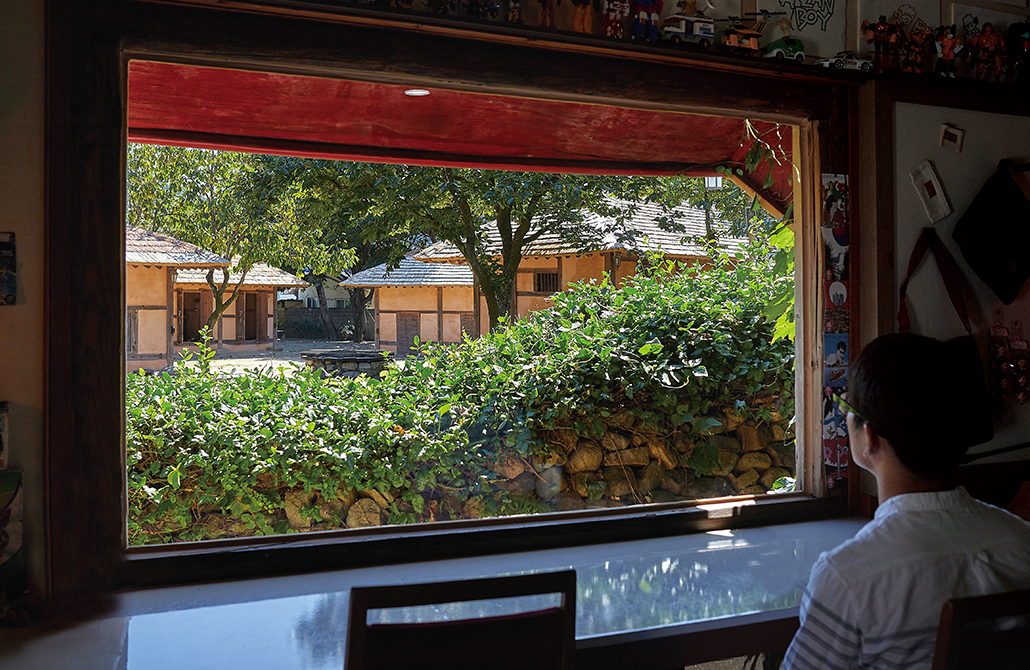 A tourist can be seen looking over the window at the Birthplace of the Kim Daljin.
A tourist can be seen looking over the window at the Birthplace of the Kim Daljin.Other Articles















